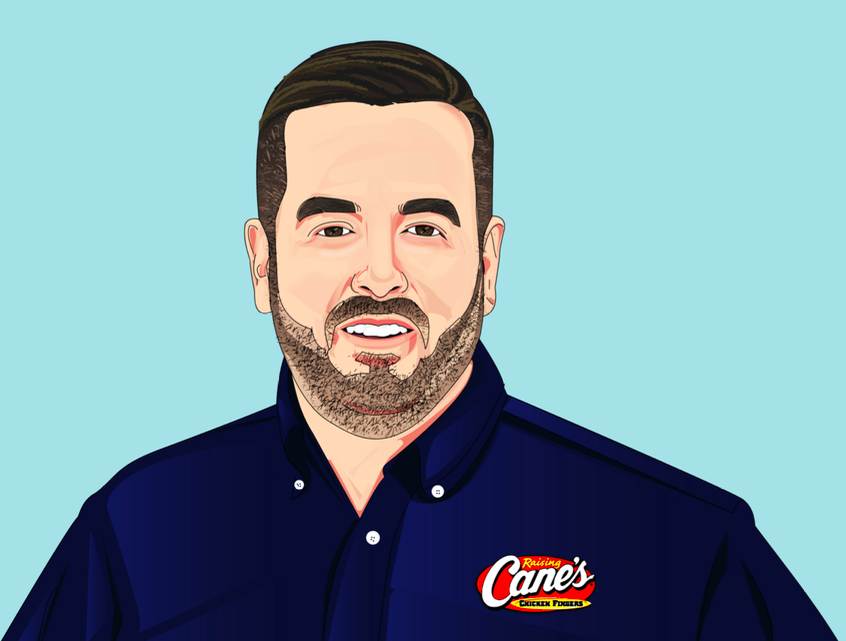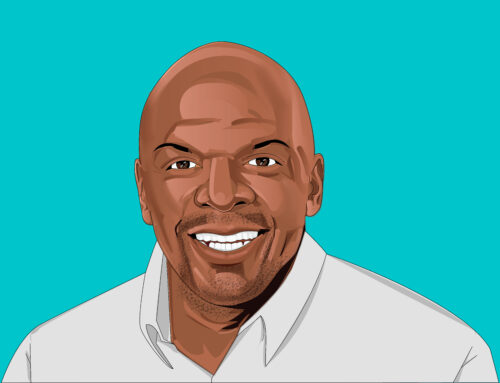JD Cummings Talks Company Culture and Best Tactics!

In this episode of Talent Chronicles, JD Cummings joins us to talk about company culture and the ideas of reward, recognition, and respect. JD is a well-versed expert in the industry as VP of Recruiting, Fry Cook & Cashier at Raising Cane’s Chicken Fingers. JD talks best tactics used for recruiting & how to improve show rates and retention rates.
JCSI: Hi everybody. This is Bergin Sullivan with JCSI. I’m here today with JD Cummings, joining us for an interview in our Talent Chronicles series. Thanks again, JD, for being here today.
JD Cummings: Thanks for inviting me. I appreciate the opportunity to chat.
JCSI: Yeah, of course. You’ve been working in Recruiting and Talent Acquisition for around 20 years with your experiences starting in the education industry at Johnson and Wales University, leading to the restaurant industry at Chipotle, all the way to your current role as the VP of Recruiting with Raising Cane’s.
Could you give us a quick background of your work experiences and tell us a little bit about how you got into Talent Acquisition?
JD Cummings: Yeah. I grew up in the restaurant industry. With my father being in the business when I was younger, I worked in restaurants all the way through high school and college. When I went away to college, I started working in the admissions department while I was in school and got a little bit of that experience of recruiting as far as recruiting college students to attend the university. When I graduated, they were opening a new campus and I had the opportunity to go out and work in that college recruiting world for about eight years. I loved it. I really enjoyed my time there. But I was looking for a little bit more of a challenge and wanted to get back into the restaurant space. That’s when I found the opportunity with Chipotle. I started out as a field recruiter there, working my way up to an enterprise recruiting leader at the support office. Then, I got a call from a headhunter about this amazing opportunity with Raising Cane’s. It was a very fast-growing restaurant company that, at the time, was at 250 restaurants and was looking to grow. Almost on a similar path to what Chipotle was, that meteoric rise in the industry. And today, we’re at close to 600 restaurants. So, just in the last five years, I have been able to experience a lot of growth within the organization.
JCSI: Nice. I did notice on your LinkedIn profile that some of your corporate employees will spend time working in the stores with the hourly employees. Have you seen that benefit your company culture? What else have you learned from those experiences?
JD Cummings: Yeah, that is what’s interesting about that initiative. We have been struggling with staffing just like any other company is today and, to understand why that initiative makes sense for us, you must understand a little bit about our culture. Every single crew member or every single employee in the business come in starting out in restaurant training. It does not matter at all what their job title is or what their role is in the organization. CFO or entry-level fry cook and cashier; everyone goes out and gets that by cook and cashier training certification. We all wear that on our sleeves. It says fry cook and cashier, it’s on a business card, on my LinkedIn profile and email signature. We wear that proudly and that’s something that we earned. Everyone who comes into work in the business has intimate knowledge of what it’s like to work in the restaurant. We’ve spent time working in the restaurant. And so, this call to action of, our restaurants are understaffed, right? They need help. In some cases, we need people to go out and just work in the restaurants to help support our teams. That was a very easy call to action. In fact, we had an overwhelming number of volunteers that were willing to go out.
I worked a few shifts in some of our local restaurants here in Dallas, in addition to going out and helping recruit. The other half of that equation was not just asking some of our support office folks to go out and work in the restaurants but asking them to go out and create an army of recruiters that could help us reach a broader audience of candidates.
Traditional recruiting methods in a talent environment like we’re in today such as posting jobs, sponsoring jobs, advertising, and even some of the active sourcing measures; going through resume database, or using LinkedIn to source candidates has not been as effective because of the status of the job market. What we found is by getting out in the communities and going out and seeking people out and having conversations, even if the person that we’re talking to in the community is not our ideal candidate or not somebody that would consider an opportunity. They could be an influencer in the life of somebody who could be a great candidate for us.
Talking with our customers in the restaurants and talking with our customers that we run into out in the community, when they see us wearing the company logo, they get excited. “Oh my gosh, you work for Cane’s. It’s so amazing, I love that place.” It opens a door for you to strike up a conversation with them and say, “I didn’t know if you know this, but we just increased our wage here in the local market. We’re actively hiring, we’re looking for some people to join our team.” Those conversations go a lot longer, a lot more towards helping us to generate candidates than I think a digital banner ad, or a sponsored job can sometimes cause people will remember those interactions and remember those conversations.
JCSI: Right. Do you have recruiting events, such as a job fair type thing, or is it you’re casually talking and its relation-based recruiting?
JD Cummings: We refer to it as boots on the ground recruiting. It’s a variety of activities. Sometimes it’s an activation, sometimes we’ll piggyback on what our marketing team is doing. If we’ve already got a marketing activation, we’ll just be there and present. Sometimes it’s working the restaurant itself; going around the dining room and clearing trays and platters from people and just striking up a conversation with them while they’re there in the dining room or standing out in the drive-through line. Although the weather’s getting a little bit colder now to be doing that but standing out in the drive-through line and just talking with cars that are coming through offering some free Raising Cane’s sunglasses, or some sort of branded swag item and striking up a conversation with them as a true Caniac. As a true fan of our brand, they’re usually happy to engage in a conversation. They’re excited that you’re giving them something free, but also, you’re able to slip in that conversation that we are hiring. And if you know anybody in the community that is looking for an opportunity. We have seen in many of these restaurants where we’ve deployed teams, we’ve seen a significant increase in application flow to follow those engagements.
JCSI: That’s awesome. It does look like you have a lot of experience with high volume recruiting for those entry level roles like you had just mentioned. I’m curious to know how you’re getting those candidates to show up for interviews. Specifically, those fry cook and cashier roles. What tactics have you seen that will give you higher show rates? What tactics don’t work? Just kind of some advice around that?
JD Cummings: Yeah. I think it’s obvious to say this, probably not saying anything that’s revolutionary, but I think understanding that most of the candidates in that space, that entry-level hourly workforce. Their predominant consumption of internet access and engagement with technology is going to be on a mobile device. I think focusing on a mobile first platform for your talent acquisition technology stack is critical. We did that very early on to make sure that we saw the numbers, and this is back in 2016 when we first launched our new ATS. About 60% of the traffic on our career site at that time was coming in on a mobile device, not on a desktop laptop or even on a tablet. Making sure that that environment is great and as easy and as frictionless as possible. If you think about somebody who is applying for an entry level job that might pay somewhere between 10 to $15 an hour or whatever the pay rate is in that area. They probably don’t want to spend a lot of time completing an application. I find that quite frankly, a lot of that is wildly unnecessary. A lot of the information that we, on a historical basis have collected on applications is not needed, especially for an entry level job. If this job does not have any work experience requirements, why are we asking all these questions about work experience? If this job does not have any educational requirements, why are we asking all these questions about their educational background on an application for that entry level role? We removed a lot of that from our application process, made sure it was mobile first. We’ve also added SMS technologies to ensure that we can communicate with candidates where they are. Hardly anybody answers a phone number that they don’t recognize, right? Because it could be spam call or something. So, calling candidates after they’ve applied doesn’t necessarily work as effectively as it would have maybe 10 years ago. This SMS technology allows us to be very upfront with who we are and say, this is Raising Cane’s. Provide them with that opt-out through our SMS solution integrated with our applicant tracking system. So, providing them that opt out, if they choose not to communicate with us via SMS, they can hit stop. It’s done, we can no longer message them that way. But we do see a much faster response rate from candidates, a much higher conversion rate to interview by utilizing that text messaging through the applicant tracking system. And that way, we’re compliant. All those conversations are being documented but we’re also ensuring that we’re reaching candidates where they are and where they’re spending most of their time.
JCSI: Sure, that makes sense. We’ve been implementing a lot of that too lately. It works for those hourly roles. In terms of interview show rates and retention rates, there are two things that we’ve noticed. I’m sure everyone else in the industry also has, that have been decreasing recently.
What have you seen for retention rates for your hourly roles? What have you implemented to help keep those higher? Have you done anything like higher pay, or sign on bonuses, anything like that? Any sort of incentives?
JD Cummings: Yeah. I’ll talk quick on retention rates. We’ve had historically high retention rates and I think part of that has to do with the culture that we have worked so hard to cultivate here within the organization.
Working in the restaurant industry is not necessarily one of the sexiest jobs that’s out there. And so, there’s not a lot of people necessarily vying for that. You don’t go to college and get a degree to go become an entry level restaurant employee. But it can be fun, and it can be a really great work environment and all that. We want to prove that is the case. We’ve created this culture that’s founded in respect, reward, and recognition. We know that we’re asking people to work hard. We understand that this is not easy work sometimes. But we want to make sure that we respect everyone, regardless of where they come from, regardless of their title, regardless of any situation; every crew member in the business is respected equally. We want to make sure that people feel rewarded and recognized. We want to have fun while we’re working. That’s a big part of our culture here is proving that you can come to this type of environment that in most restaurants may not be perceived as a fun job to have, we want to make sure that we can do that here.
We allow crew members to customize their uniforms a little bit, picking different colors and variations. We crank up the music in the back of the house, our crew members will be dancing and having fun. It translates into a better customer experience to when your crew members are really enjoying their time there.
Overall, that leads to better retention amongst those employees. When you talk to our crew members, you’ll hear directly from them. If you were to go into a Raising Cane’s state and ask them, “hey, how long have you been at Raising Cane’s? And why have you stayed working here?” People say “I genuinely enjoy it. I genuinely have fun when I’m here. It feels like a family.” That helps significantly with our retention rates. That culture piece is so critical. I think in any industry, but particularly in restaurants where it’s a service industry, we’re all together working to serve our customers and to provide a great meal for them. As far as higher pay and sign on bonuses, we have invested a lot. In fact, recently we’ve invested about another hundred million dollars a year in our wages for crew members and enhanced wages for some of our management roles to make sure that we are staying competitive with the marketplace and rewarding all our folks for the work that they are putting in.
There’s a bunch of our markets where we had moved to a $15 an hour wage. Self-imposed across the company, not necessarily a minimum wage mandated by a municipality. But across the business, we’ve increased wages significantly. We’ve given a lot of bonuses back to our crew members. In fact, throughout COVID-19 we did not furlough or lay anyone off at all. Our restaurants completely stayed open that entire time. As we emerged from the lockdown and as our sales began to return, we went back, and we rewarded all our managers by making their bonuses whole to what they would have been on our original sales plan. We also went back and gave our crew members “thank you bonuses” for thanking those crew members that did stay with us through the pandemic and remain working throughout COVID-19.
As far as sign-on bonuses are concerned, it’s not a strategy that we deploy very often. It is something that we use when we feel like it’s necessary. Like if we are opening a new restaurant in the summertime, for instance, a lot of times in the summer we’ll have a lot of high school students that will come and apply for us because they’re wide-open availability, which is great, and we love that. We want them to come work for us, but then come September, we may get hit with a significant amount of turnover because their school schedule doesn’t allow them to work as many hours as they could have in the summertime. We might offer a retention bonus there, a sign-on bonus that gets paid out after 90 days; it says, you’re starting with us at this new restaurant in July, if you’re here mid-September working X number of hours a week, you can get this $250 bonus, something to that effect. That helps mitigate how much turnover we’re going to experience come September when the semester changes. And it helps us to recruit more people that will have that wide open availability. We do use those, but we use them very sparingly and strategically when it makes sense to do so.
JCSI: That makes sense. When hiring great talent at the hourly level, what would you say is the importance of employee value proposition? I know you already mentioned a few things, but how do you really make your employees feel important and necessary?
JD Cummings: Respect, reward, and recognition. Yeah, we have an entire department, an entire segment of our business called Cane’s Love. Some organizations might call that their employee recognition programs or something like that. But for us, Cane’s love is so much more. It’s a part of the culture. It’s a part of who we are. Sometimes it’s those little things that as a leader in the business, you might not think that that’s a big deal, or you might not think that that’s important, but to our crew members, it is important. A little handwritten card, to say “hey, thank you for your support. Thank you for all the things you do.” In fact, I have a card tacked on my bulletin board here. This is one of the cards that we provide, and leaders can have their custom tag on it, and they can write a note. One of our leaders in the business wrote me a note one day and said, “hey, thanks for all you do for the business.” That means a lot to me, that little gesture. It doesn’t cost very much to do that. And we have a lot of that across our business. But Cane’s love for us, it’s a significant budget within our business. We dedicate a lot to that. We do little things like right now is Thanksgiving. We give all our managers, support office, and crew members in the business a $20 gift card so that they can use that to go to the grocery store, buy a Turkey, a ham or something so that when they gather with their families when we’re closed on Thanksgiving, they can go sit down and enjoy that time with their family.
We know this is a hard business. We know that people are going to be working hard nights and weekends sometimes in our restaurants. And we want to make sure when they do have that time off, that they really take that time seriously to go enjoy time with their family. At Fourth of July, we give everybody ribeye steaks. They can go out and grill with their families and enjoy Fourth of July. Our restaurants are closed on 4th of July, which is unique. Little gestures like that to say enjoy that time.
One of the more unique stories is when we first opened in August of 1996. So, we’re on our 25th anniversary right now. Right after Todd had opened the very first restaurant in Baton Rouge, Louisiana. We came up upon the very first holiday that was around the corner, which was Halloween. And Todd really wanted to do something for the crew to reward them to say, thank you for all your hard work. And he didn’t have a lot of money and resources to be able to provide them with something. But he remembered when he was in elementary school, his teachers used to give them ghost pops, which is a tissue wrapped around a blow pop, or a Popsicle or a lollipop. And it had a little ghost face drawn on it. He made ghost pops for each of the individual crew members with that little note that said thank you for your hard work. We still do that today. We must source 50,000 of these ghost pops across the business, get them out to our restaurants and have them deliver it. And there’s a little story in there that talks about our culture that explains we really appreciate all that you do. We know this is a small gesture. There’s a story behind this, it goes back to the original restaurant back in 1996 in Baton Rouge. There are little elements of that, that we carry it through in our culture today that are an important part of making sure that your crew members feel important. Again, it’s that reward and recognition. We are asking you to work hard, there’s a reason that you get paid to do the work that you do in any job. It’s because it’s not easy, it’s hard. We want to make sure that we say, “in addition to the compensation and benefits and all this stuff that everyone gives you, we want to make sure that you feel rewarded, genuinely appreciated from the company and from your direct supervisor, from the leaders that you work with.”
JCSI: I love making that connection too, between the corporate office and your employees who are actually in the restaurants, because I feel like sometimes there can be a disconnect with big corporations like that, but it seems like you guys do a good job at including everyone.
My last question here, do you have any advice when writing either job postings or job descriptions for those hourly roles? Any language that you feel can be more enticing for workers, or anything that you can go into around that?
JD Cummings: I think job descriptions sometimes become more legal documents than they are a job advertisement. I think that you must try and strike the right balance between both. Certainly, you need to include all the language that needs to be covered in your job description about the requirements of the job so that way, it’s legally compliant. I think that’s important to include. But I think there’s elements of the job description where you can be a little more conversational. To be a little more fun and playful and talk about what it is really like to work at Raising Cane’s. This is different for high volume roles when you’re hiring the same position repeatedly. But even for some of those roles, I always tell a hiring manager when you’re approaching a job description, imagine if you were sitting down to have a conversation with a potential candidate and you’re attempting to sell them on what this role is in a very authentic and genuine way. How would you have that conversation? Use that as a stream of conscious as you’re writing the job description and then edit it from there so that it makes sense as a job description. But how would you describe this to them in a very clear and concise way that they would have a strong understanding of the role? I think if you focus on that in your job description, you can be fun and playful. You can talk about the wonderful things that this job will bring. I also think it’s important to lean into some of the harsh realities. I don’t think you should try and sugarcoat any job and you should make it sound like it’s all sunshine and rainbows and unicorns and there’s nothing hard about this job. I think you should lean into that and say there are some things about this job, but in return, here’s what we’re going to give you. Here’s what you’re going to provide us. But also here are the rewards that you’re going to reap from that hard work.
JCSI: Sure. Those were all the questions I wanted to run through. Are there any final thoughts, anything that you didn’t get to share that you want to talk about?
JD Cummings: No, I appreciate you allowing me to be a part of this. I think it’s a great series and I’ve followed your podcasts up to this point. I’ve learned a lot from other Talent Acquisition leaders and I’m happy to be able to provide some of my experience as well.
JCSI: Awesome! That makes me so happy to hear. Well, thank you so much again for joining us on an episode in our Talent Chronicle series.
JD Cummings: Thank you so much. Have a great day.
JCSI: You too.
Talent Chronicles is brought to you by JCSI, an innovative recruitment consultant that delivers better hires, faster, and at less cost.




